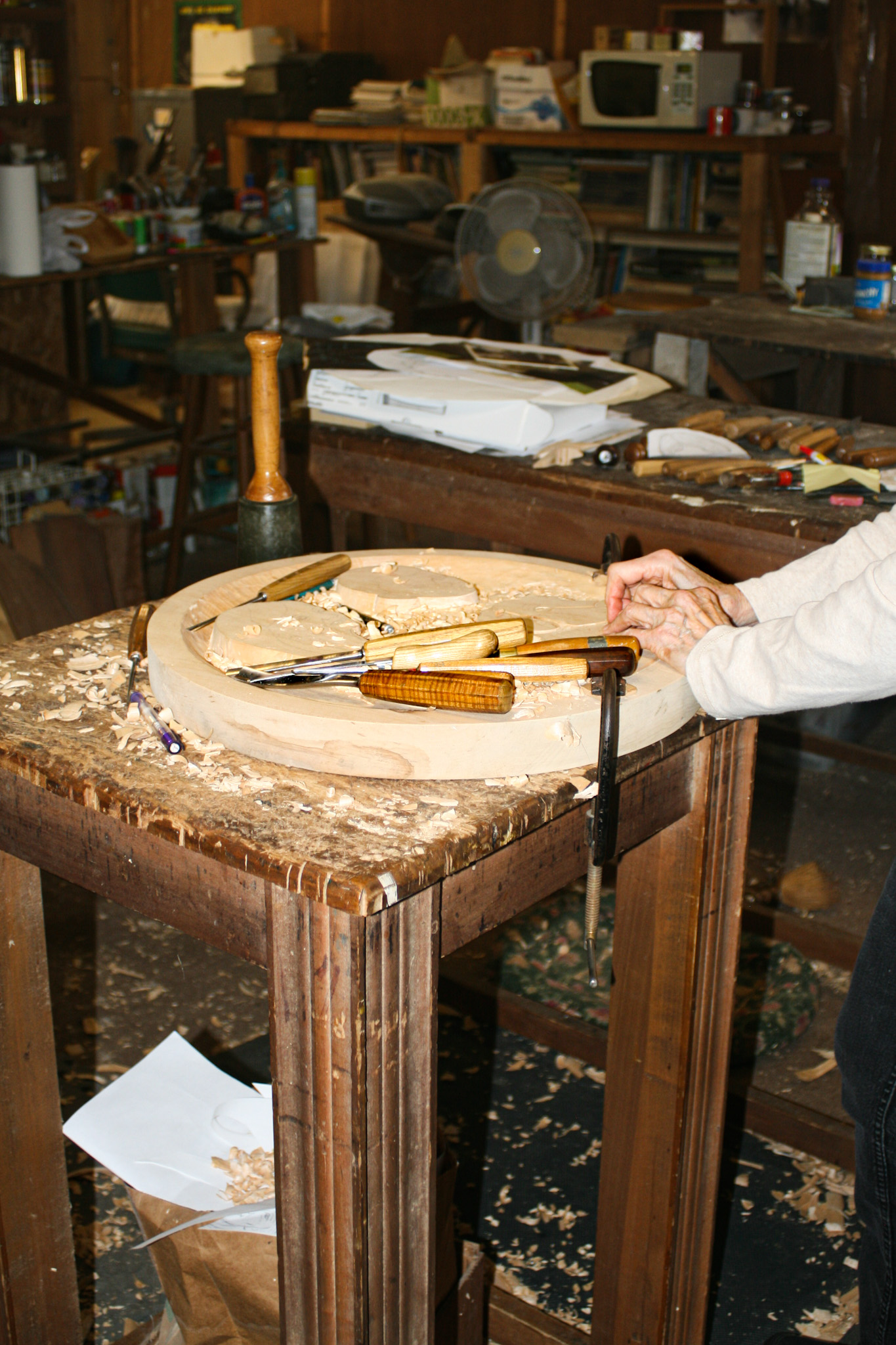
Two months, an X-Acto knife and a hunk of scrap wood from a construction site. These are the supplies master wood sculptor Spirit relied on for one of her first projects 53 years ago at age 27. Spirit used the uncommon tool to whittle away at the core of the wood and at the core of her being, too. This revealed a passion for the art that she has not dropped since.
“Spirit. Like Cher. Madonna. Spirit,” the incisive Spirit says about how she is referenced.
Like these other mononymously addressed women, Spirit is driven and hard-working. Her lifestyle, however, is not that of fame and glamour. Her gallery and studio, Spirits of the Hills, is nestled in the Hocking Hills countryside. She also defines artistic success with one word: happiness.
The gallery leads to her living room. Sloping, shelved bookstacks wrap around the art-adorned walls. A charcoal gray cat named Smoky whisks her tail as she makes herself comfortable in Spirit’s lap.
“We aren’t crazy cat ladies because we only have eight, not twelve,” Spirit says — with a wink.
Now 80 years old, Spirit has produced hundreds of carvings with advanced tools. Some include flared, concave-bladed gouges in varying sizes. Her work ranges from picturesque “relief” carvings to working “in the round,” or three-dimensionally.
Spirit was inspired to pick up the hobby knife when her ex-boyfriend’s friend lost his legs in a sailing accident.
“They started him on carving because it is a wonderful therapy. So, I saw him carving, and he wouldn’t let me touch his tools. He said I would get them dull,” Spirit says, jovially laughing at the memory.
“I went to the library, of course, and got a book. The first line said if you cut yourself more than twice, you should quit. Ugh! Didn’t look at another book for years,” Spirit says.
Before discovering her aptitude for woodwork, Spirit worked for an insurance company for “10 whole months. It was hell.”
Her sparky personality was suffocated by the mundanity of working in an office.
“I’d be over in the corner doing pushups. I’m just not designed for a desk job. So, I quit,” Spirit says.
After selling her first piece, Spirit left her job, worked as a waitress and began to wood sculpt for a living.
Spirit’s studio is surrounded by rock faces, a vegetable garden and wildflower patches. She pushed open the door to her woodshop after shuffling past weathered beekeeping hive frames. Earthy lumber and dried lemon balm permeated the air of her workspace.
Hand-gouged, wooden slivers curled across the floor like confetti. They rippled outward from the table where Spirit was working on her latest commission. Despite living with chronic fatigue syndrome, she has recently worked up to an hour and a half in the shop.
Spirit sifted through side projects, wood stacks, scattered tools and (of course) a couple of cats. This is where Spirit prepares her herbal tea — her current favorite is made of dried lemon balm leaves from her garden. Then she begins to carve and participate in a remarkably intimate relationship with her medium.
“There is such a deep connection with wood … Like fire and water, it’s intrinsic to our natures. I couldn’t imagine living in a desert and not having wood around me,” Spirit says.
Spirit acknowledges her chosen medium as a sentient being or entity, noting how trees communicate underground through root systems. She respects the way wood services humanity by providing oxygen and shelter.
“You know The Giving Tree. It’s true. They are so there for you in every aspect of your life,” Spirit says.
Spirit can craft anything one’s heart desires, from grandiose commissions for churches to etchings of people’s trucks. Her favorite is depicting living subjects, like people and wildlife, with a free-flowing composition. She prefers to use locally-sourced, native woods — especially smooth basswood.
Spirit has a penchant for detail in portraits. Though countless hours can be spent on a project, her favorite creation is a self-portrait carved in just three hours.
“It just fell into place. It was perfect,” Spirit says.
She stresses the importance of working with — not against — the wood. While one might see a knot in the wood, Spirit sees the cliffs of the Oklahoma farm she grew up in. While one might perceive grain in the wood, Spirit perceives a rippling blueprint of flowing hair. If one fails to follow the grain, the wood is prone to split.
“That is the essence of art: actually looking and actually seeing what you’re looking at. Suddenly, I began to understand people better — because I was actually looking instead of assuming, like most people do,” Spirit says.
Spirit has sold pieces overseas to individual buyers in Europe, Asia and Australia. A sculpture of hers is currently valued at $84,000. Despite her mastery of the art and prolific body of work, Spirit has never seen anywhere near those numbers in compensation for her carvings. It is not money, however, that calls Spirit to create.
She has a theory for why the “starving artist” trope exists: Artists will create “because they have to. The art will be there whether it’s paid for or not,” Spirit says.
She believes wood carving is the oldest art, tracing back to when hunters would mark trees to find their ways home. She also sees it as the least-respected art because people view it as a hobby rather than a way of life.
“When I’m doing a show and somebody walks past my booth with just a glance, I think: ‘Even if you don’t like my carvings, how could you walk past the wood?’ Wood is just so beautiful,” Spirit says.


